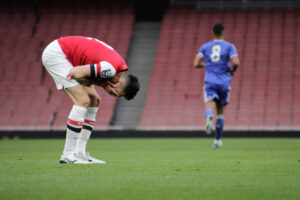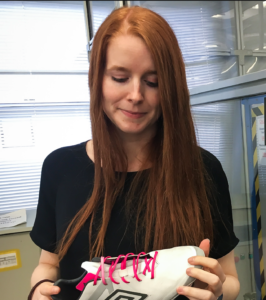Are ACL injuries in Women’s Football on the rise? – A researcher explains
Dr. Katrine Okholm Kryger has been working as an academic in sports medicine for four years and joined St. Mary’s University in Twickenham as a Sports Rehabilitation lecturer in 2020. Among other things, the 32-year-old specialises in female football health and football boot research.
We had the chance to discuss ACL injuries in women’s football as well as other aspects that have an impact on this particular injury type like wearing the right football boots, the differences between male and female anatomy and the importance of Equal Play.
One of the hottest topics in the medical research of women’s football that is omnipresent in the media are ACL injuries. This year alone we heard of injuries from Ballon d’Or winner Alexia Putellas (FC Barcelona), Germany’s Giulia Gwinn with her second ACL injury, French international Marie-Antionette Katoto (PSG), and many more.
When asked about the seemingly high number of ACL injuries, Kryger reminds us that “you have to be careful with what you see in the media and what the data actually shows.” She elaborates that researchers have actually observed a downwards trend of cases in women’s football. However, she does not rule out the possibility that the coronavirus could have had an influence on the matter.

Dr. Katrine Kryger: Photo: St. Mary’s University Twickenham
There is still not enough research in Women’s Football
According to Dr. Kryger, the most important aspect to prevent ACL injuries is having experts as part of a team’s staff. This means having the right strength and conditioning coaches as well as having the right medical staff that understand women’s football. They should not “just copy what goes on in men’s football” but instead apply their knowledge specifically to women.
“It’s very exciting to be part of making that change in terms of research,” Kryger explains. Especially because of the Euros in England and the success of the home team, this country has experienced a grand explosion in attention for women’s football.
Kryger believes this is also a reason for more people with a medical background to get involved.
Female footballers get ACL injuries more often than men
What researchers can already tell is the fact that the female and male anatomy is different in many ways which also influences injuries. Women are indeed more prone to ACL injuries while men get more hamstring injuries, says Kryger.
This can be verified by the current injury list in the English and German top leagues (data collected on November 9th):
- In the Premier League 1,17% of players (6 out of 512) are currently diagnosed with an ACL injury while in the WSL it is 4,14% (12 out of 290).
- The Bundesliga registers 1,37% of players (7 out of 511) with an ACL injury. In the women’s Bundesliga 2,47% (8 out of 324) are affected.
With her colleagues, she did studies on how the menstrual cycle affects amateur and elite female football players. So far, there is not enough evidence on the medical side.
“There’s no hormonal nor physiological reasons why there should be a bigger risk”, explains Kryger, but the study showed that when on their period players think that the risk of injury is higher. This can probably be traced back to a lack of confidence when on their period.”
So far, research only shows us that injuries during periods might happen because players go into tackles differently. This means periods can have a psychological impact on the players.
As for the emotional factor, Kryger stresses: “Men are as unstable as women”. Both sexes have to deal a lot with stress during their personal lives. Therefore, both men and women are affected by the consequences on a performance level.

Where are the football boots for women?
Another part of research which is only just getting started takes on women’s football boots.
“We really try to improve the data available for manufacturers to design women’s football boots, because currently we don’t really have any on the market.”
The shocking news is that the supply of football boots on the market that are made to the measurements of a woman’s foot is extremely low. Indeed, when a woman is looking for ‘female football boots’ on the Internet, she gets pink men’s football boots as a result – the ‘Pink It and Shrink It’ method, as Kryger calls it.

Dr. Katrine Kryger, inspecting a football boot; Foto: Dr. Katrine Kryger
This is a serious problem for women in football. Female feet differ a lot from males in regard to form, size and the weight they have to carry.
In preparation for next year’s World Cup, large companies are to launch their first football boots for women. Kryger emphasizes that before there has not been a lot of research and data on the matter.
ACL injuries often happen during rotational movement. Wearing shorter and smaller round studs on your football boots can decrease the likelihood of getting stuck in the ground during a turn or change of direction.

But most importantly, wearing comfortable shoes increases the confidence in a player’s performance which again serves as injury prevention.
Equal Play could decrease ACL injuries
Not only the boots but also the pitch can impact ACL injuries. Especially on artificial grass the risk of studs getting stuck in the ground are higher. Kryger claims that instead of changing between normal and artificial grass it is safer to stick with only one of them – preferably grass.
Artificial turf pitches have no future according to Kryger. Due to EU regulations that will come into force soon the microplastic used for the pitches will be banned.
Improving the pitch quality is part of the “Equal Play” women in football are demanding. There are some improvements with bigger games taking place in big stadiums as we saw with the Arsenal game breaking Premier League records. Nevertheless, many league games are still played on amateur pitches that male teams have played the day before.
Another important point is the extremely high physical strain in the span of only one year with both the Euros and the World Cup. Some players additionally play in the Champions League and cup tournament which already led to a lot of injuries. Clubs like Olympique Lyon and FC Bayern Munich must do without some of their most important players right now.
In the end, Kryger reminds us, that the research about ACL injuries in women’s football is only the tip of the iceberg. They have to collect a lot more data as there are still many topics untouched. So there is always something to do for Kryger and other researchers.
“That’s what makes it interesting.”
READ MORE:
The Women’s Champions League Group Stage – More exciting than ever before